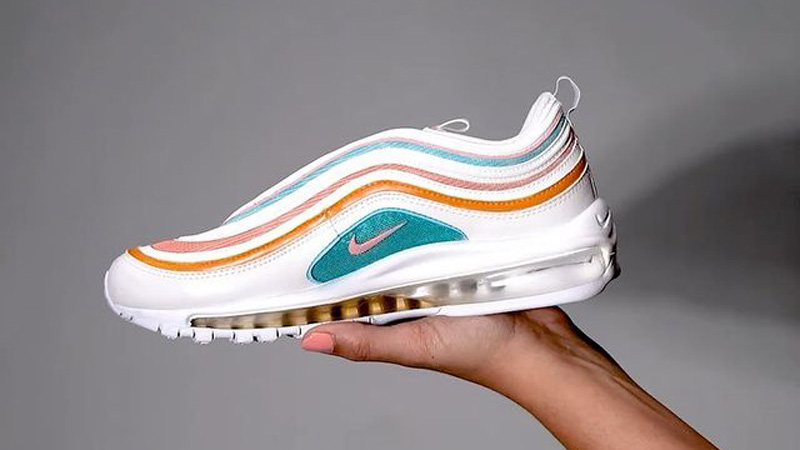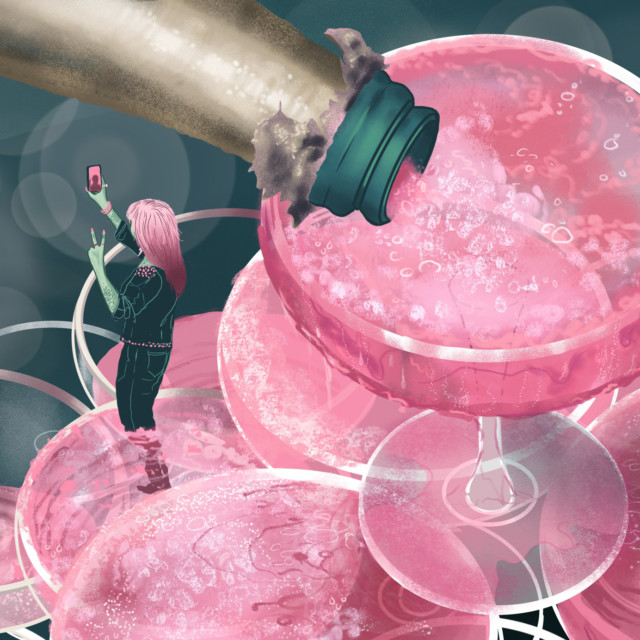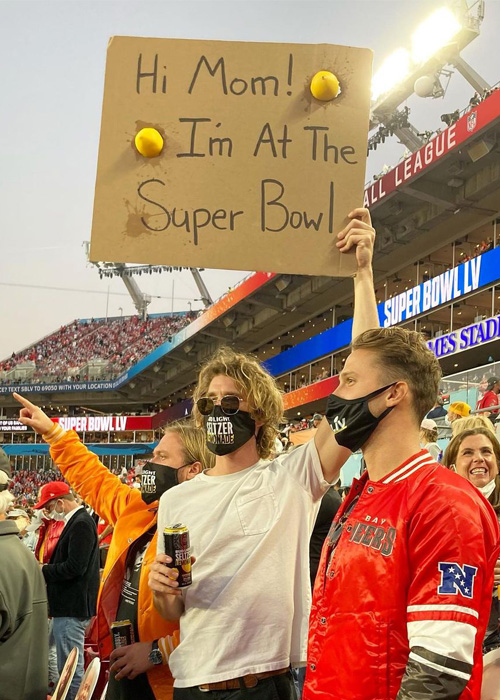Today, the candy-colored world of social media booze and bartending is fueled by a higher power. Even content that feels relatable, or runs without a sponsored tag on platforms like Instagram and TikTok, was likely highly designed and curated by not only an influencer — but an influencer marketing agency.
At this point, most people understand that when an influencer recommends a product to their fans, the content is considered “influencer marketing.” But what many don’t realize is that these deals are rarely made directly between the actual influencer and the brand.
Instead, the brand will contact an agency, which is then responsible for identifying a collection of influencers, brainstorming content, and promoting targeted ads from an influencer’s account. For alcohol brands, these agencies make observing FTC guidelines easier, as there are several benchmarks sponsored or branded content must meet. Most notably, any sponsored post promoting an alcohol brand must broadcast to an audience where roughly 72 percent of viewers are of legal drinking age.
From there, the content has to appear natural, which has led to an influx of micro-influencers “authentically” discussing their favorite beer or tequila to an audience of just a few thousand.
Compared to just a few years ago, now there are millions of micro-influencers listed for hire on platforms like Izea or Tagger, all trying to secure a piece of what’s predicted to become a $15 billion industry by 2022.
Ever wonder how that perfect pilsner made its way onto your feed? Here’s a glimpse into the strategic world of beverage influencer marketing.
The Influencer Marketplace
First, to really understand why influencer marketing agencies exist, one has to understand their counterpart: opt-in programs.
These programs are often associated with influencer marketplaces (like the aforementioned Izea or Tagger) where brands essentially post assignments to a job board. There, influencers can bid on jobs, and many will take an assignment for very low rates.
Erin Ledbetter, senior vice president at the influencer marketing agency Carusele, explains that “one of the benefits of working with those influencers is you can get [work] done very, very cheaply and you can get content out very quickly because they’re just churn and burn.” The somewhat obvious downside: Because many of these folks are just starting out or trying to grow their modest followings, “you end up working with influencers who aren’t actually influencing anybody.”
Additionally, the percentage of sponsored content these influencers are posting is usually very high, and can stream out to unengaged or even fake, purchased followers. An agency like Carusele will vet these influencers by deploying a Qstack ranking system that measures audience authenticity, engagement, and growth. Once a creator passes these benchmarks, it’s just a matter of making sure they fit the campaign and, as Ledbetter emphasizes, can actually influence.
Picking the Right Platform
Today, the majority of boozy influencer marketing campaigns are taking place on Instagram. There, companies can easily access a breakdown of any user’s audience — unlike on TikTok, where only influencers registered in the “creator marketplace” will come with comparable audience breakdowns. These metrics are important because at this point, advertising alcohol on TikTok is still illegal. Theories as to why fly on both sides, but generally have to do with age. Some trace the platform’s hesitation back to issues it saw as Musical.ly, when it was penalized by the FTC for not protecting its underage users. Others point to the platform’s recent partnership with the Portland Timbers and Thorns, the inevitable tie between sports and beer, and say it can’t be too long before the platform amends its regulations.
That said, plenty of contracted influencer content still makes its way to TikTok. Nicla Bartoli, vice president of sales at the Influencer Marketing Factory (IMF), explains that brands will often “use TikTokers as a source of cool content, and then distribute it across other social media where they have more say in the compliance.”
When IMF was asked to help Bud Light secure content for its first Instagram reels, it looked to popular TikTok influencers like @lilyxlei. And while Bud Light commissioned the content specifically for Instagram, many influencers couldn’t help showing off, and posted the videos to their own pages — despite Bud Light not asking them to.
@coolestdad.24__ Growing budlight!! #budlightseltzer #budlight #budlightgarden #budlightlime #fouryoupage #fyp #4upage #4uyou #huntingandfishing
Whether an outcome like this was intended can’t really be known. But while a booze brand may not be formally spending its marketing dollars advertising on your social media platform of choice — or even be allowed to – if it pairs with a savvy agency that picks influencers wisely, the resulting campaign might still find its way to millions of unknowing viewers all the same.
Going Viral vs. Going Local
“When it comes to alcohol, there are two angles that brands usually like to take,” explains IMF’s Bartoli. “One is to go niche — they want us to hire people who really understand about the alcohol, mixologists, bartenders, people who have an account that really know their stuff, right? Whereas other brands want to go broad.”
One of the issues with going “broad” — which essentially means choosing an influencer with a large enough following to make a campaign go viral — is that making a splash means reaching users who may not be of age. This means it’s up to the brand to create an innocuous campaign that can be shared across demographics.
One example comes from JAJA Tequila, which gained 17,000 followers in a day after dropping a pair of JAJA Tequila x Nike Air Maxes.
Now, JAJA Tequila is perhaps better suited for the world of influencer marketing than other brands. Co-created by Elliot Tebele (the man behind @F*ckJerry and Jerry Media), the brand itself launched with a strong pool of in-house influencers and accounts to pull from. Pronounced “haha,” JAJA was essentially created to fit F*ckJerry’s current audience and has led humor- and hype-driven campaigns that feel very authentic to the brand. To promote the brand during the pandemic, it turned to Jerry Media’s own @DudeWithSign (DWS), who has also been tapped for campaigns with Bud Light, Old Spice, and BMW.
https://www.instagram.com/p/B_gDI06lU3j/
In another example, Ledbetter of Carusele explains her agency was hired to boost a new vodka brand that only had retail pickup in the Chicago area. She called the brand “ripe for influencer storytelling,” but emphasized that it needed to rely on hyper-local targeting.
While all of the campaign’s influencers were from Chicago, only 10 to 30 percent of their audiences lived in the city, meaning there would be at least 70 percent “waste” on organic impressions, or total views from their followers, which isn’t ideal.
To combat this, Ledbetter explains her team used “c-stack data to layer in media syndication,” which meant running a proprietary algorithm to determine the strongest content, and then figured out the best way to promote it.
Next, the team ran ads from the influencer’s channels that were 100 percent targeted to people over the age of 25 living in the Chicago area, who had an interest in spirits. The result? “We ended up delivering 97 percent of the impressions on that campaign to that very narrow audience,” she says.

Hitting Targets
This kind of data-driven campaign is where alcohol brands can really benefit from hyper-targeting. While the FTC guidelines may make it harder for a beer, wine, or spirit brand to launch an influencer campaign with a silly dance move or roller-blading backflip alone, those viral examples are really just jumping-off points for the precision targeting today’s digital advertising allows.
As influencer marketing continues to expand across every category — and onto every platform — craft brands should consider their options. For most, social media has long since stopped being the afterthought kicked over to the millennial assistant. But now, promotion across these channels is something to contract out to a professional agency, and has become a meaningful and effective way to reach millions. As campaigns and the apparatuses behind them become more sophisticated, it’ll only be a matter of time before every hype beer, color-changing gin, and low-calorie wine makes its way to TikTok — if not your personal news feed.
This story is a part of VP Pro, our free platform and newsletter for drinks industry professionals, covering wine, beer, liquor, and beyond. Sign up for VP Pro now!

